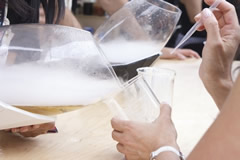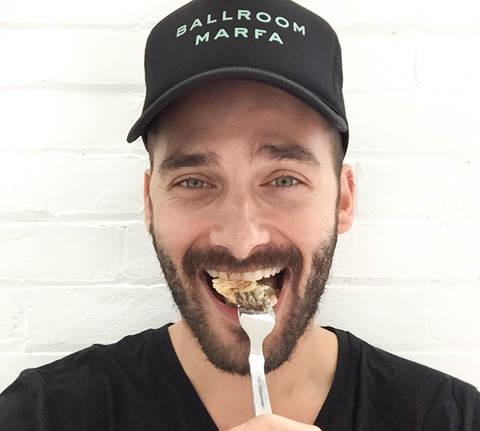It’s not easy for Irwin Eydelnant (PhD 2013) to explain what he does for a living. He works with food, but not in the way a chef does – although there’s some of that. With a background in biomedical engineering, Eydelnant takes more of a scientific approach to food and how we experience it through our senses. He’s also an entrepreneur, seeking new ways to engage people with food – to create new “food experiences.” We reached him on the phone in New York.
How would you describe your job?
I’m the founder and creative scientific director of Future Food Studio. My team thinks about food from many different perspectives. We develop new food products, think of new ways to consume food and develop new tools for people to interact with food. We also create environments in which to eat food, such as retail spaces and venues at art and music festivals. The work we do is divided relatively equally, with half focused on client work, with large food and beverage companies and hospitality groups, and the other half on research and development.
Though our research is quite conceptual, we try to create tangible items out of it – such as a spoon that allows you to taste sweetness without sugar being present, or a fork that allows you to taste saltiness without having salt. My goal is to make people more conscious about the way they consume food – but in a way that delights them, not by telling people what to do.
How does your graduate degree from U of T feed into the work you’re doing now?
My PhD in biomedical engineering gives me a background in technology and how to build systems from the ground up – making things that have never existed before. Because of this, creating new things became part of my DNA.
And why food?
I grew up in Winnipeg, and the one thing I remember happening every day was my family sitting down for dinner together. It didn’t matter where we were or what we were doing, coming home for dinner was a must. When I left for college, I quickly found that I would make food as a way to connect with others and to build community. I came to think of food as the ultimate social platform – an incredibly powerful tool for sharing stories and communicating with each other. That started for me at home.
Can you give me a specific example of how your scientific background has affected your career in food?
One of our original projects was creating “edible clouds,” which required a system to distribute tiny droplets and suspend them in a cloud. This was a direct translation of a technology I worked with in the laboratory for a completely different application.

What is an edible cloud, exactly?
Imagine the vapour you see coming off a humidifier. Now imagine suspending that vapour within a vessel, such as a glass. That’s exactly what it looks like, and you can flavour it any way; we’ve done citrus, cola, even hot dog. You can pour it, sip it and drink it. It’s an ethereal material that allows us to explore food while playing off of the physiological basis of taste and flavour. You experience taste on your tongue, whereas flavour is something you experience through the back of your nasal passage. As you chew food, you generate aerosols that stimulate the olfactory neurons. The idea with the edible cloud is to directly affect the olfactory neurons. Besides that, the clouds are just beautiful to look at it.
Do you have a restaurant where people can try these things?
Not right now, but we do offer workshops every month. We are working on a gallery that will be open for a few days a month where people can come and experiment with the ideas that we’ve been developing in the studio. The first one should be in Toronto in late spring.
What’s one of the most unusual inventions you’ve ever came up with?
One of the most recent ones is food that lights up. It was a classic laboratory accident. A chef, a chemist, an intern and I were working on a project. Something screwed up, but it made this edible material that was beautiful and looked like edible light. We wondered what we could actually do with it.
Where did the light come from?
The lighting is external but what happens is the material seems to illuminate further. Imagine you had an acrylic sheet and you were to etch into it. If you lit it from the side, all the etched lines would appear to be illuminated on their own. What we did is similar, but made from a combination of fresh fruit purees and protein additives.
Any other projects you’re excited about?
We’re working with a group in Toronto called Future Talk to create interactive projections on tables. We’re trying to expand on what the dining experience is and how we can communicate more with our guests during that experience.
I’m also the creative director for an expo that’s launching in New York in June called Food Loves Tech. It’s meant to be a public-facing portal into the future of food through technology. We’re pulling in some amazing partners to do a series of immersive installations that will allow people to see what tomorrow’s food looks like.
What do you find most rewarding about your work?
I work with an amazing team. Food has become a multidisciplinary field and our studio embodies this. We are a collection of artists, designers, architects, chemists, chefs, food and beverage people, engineers, computer programmers – all of whom can relate to food through their own experience, and contribute to the future of it. This puts us in a unique position and, for me, that’s a privileged place to be.
Recent Posts
U of T’s 197th Birthday Quiz
Test your knowledge of all things U of T in honour of the university’s 197th anniversary on March 15!
Are Cold Plunges Good for You?
Research suggests they are, in three ways
Work Has Changed. So Have the Qualities of Good Leadership
Rapid shifts in everything from technology to employee expectations are pressuring leaders to constantly adapt







One Response to “ Food Technologist ”
Does Irwin Adam ever visit Australia? I'd love to meet him, if he does. I live in Brisbane, the capital of the state of Queensland.